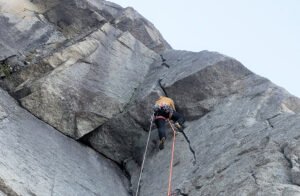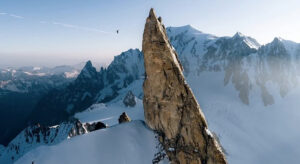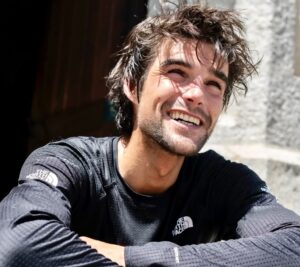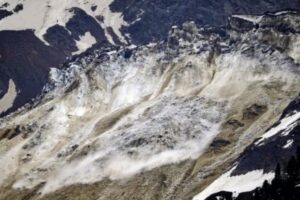Winter does not usually come as early in Europe as it does in North America, especially over the last few years. However, the first cold spells, before the snow piles up, may provide the right conditions for climbs which can be only attained under very specific circumstances. Local climbers watch and wait. When the moment comes, as it did in the Dolomites and the Ecrins last week, they pounce.
When the first cold days drove back the usual climbers on the rocky face of Mount Agner, Nicola Bertoldo and Diego Dellai grabbed their ice tools and jumped onto a thin, ephemeral line of ice in a narrow gully of the face.
Ice paradise
The climbers described it as “a living route, modeled by nature.” The climbers took this unexpected opportunity to open a new line up a face that is usually popular because of its three via ferratte. It also has over a dozen rock lines, including the Spigolo Nord (the north spur), one of the longest routes in the Dolomites.
The vertical ice line stunned Bertoldo and Dellai as they entered the San Lucano Valley and stood face-to-face with Mt. Agner.
“I never thought such beautiful new lines still existed in the Dolomites,” Dellai wrote.
The climbers went for it, and the adventure resulted in a beautiful 375m line, which they graded as 5+, M6, 50′. They called it The Last Pearl because they might never again get a chance to open such an aesthetic ice line.
Waiting for years
A similar situation occurred on 3,914m Pic Sans Nom (Nameless Peak) in the Ecrins massif. Local ace Benjamin Vedrines and partners Nico Jean and Julien Cruvellier were patiently waiting for an ice route that only forms for short periods, once every few seasons.
“We had been waiting for the right conditions on this peak for years,” Vedrines wrote.
They were looking for a thread of ice that roughly follows the peak’s Georges-Russenberger line, first climbed in 1915. But once in a blue moon, a beautiful 1,000m line of ice appears. It was last climbed in mixed terrain in 2015.
“Setting out on skis, we bivouacked at the foot of the face on snow hardened by the storm winds,” Vedrines recalled. “Then Nico and I went to fix 100m of rope to save time the next day.
The trio set off at 4 am the next morning. All went well at first, with plenty of good ice, but higher up, the ice grew thinner and more fragile. The most difficult section was also very dry.
“After a few daring steps, jamming blades in the cracks, I found myself a few meters from another easier zone,” said Vedrines. “But it took me a few minutes of hesitation to finally take the last step in powdery snow laying over smooth rock.”
The climbers reached the summit via the west ridge, on steep rock, at twilight.
“At 6:15 pm, the three of us were up there, at the top, happy!”
Vedrines admitted they didn’t enjoy the descent down the northwest couloir, but once off the peak, the ski back under the full moon was “magical”.






